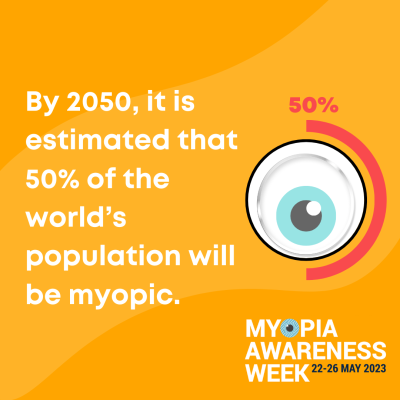Why everyone should be getting involved in Myopia Awareness Week
- Jason Higginbotham
- May 22, 2023
- 3 min read
Jason Higginbotham, the Managing Editor of Myopia Focus, has compiled his thoughts on why it is crucial for everyone to participate in Myopia Awareness Week.
Today sees the start of this year’s Myopia Awareness Week. The fact such a week is necessary is something that concerns me greatly. As an Optometrist, I’m acutely aware of the potential risk to sight posed by the worrying increasing trend of myopia incidence in this country and globally. The evidence is overwhelming. More and more people are becoming myopic [1].
You may ask yourself, ‘why does this matter’? Well, over recent years, there has been a huge amount of research into the risks associated with higher levels of myopia [2].
Most myopia is known as Axial Myopia, where the eyeball grows much larger than it should. There are numerous potential causes for this, but ultimately, lifestyle is the biggest risk factor for developing axial myopia [3].
Again, this may not seem important, but, as the table below shows, the risk of serious sight threatening conditions increases considerably with myopia and, particularly with high myopia.
| Cataracts | Retinal Detachment | Glaucoma | Myopic Maculopathy |
-1.00 to -3.00 | 2.3 | 3.1 | 2.3 | 2.2 |
-3.00 to -5.00 | 3.1 | 9.0 | 3.3 | 9.7 |
-5.00 to -8.00 | 5.5 | 21.5 | 3.3 | 40.6 |
< -8.00 | - | 44.2 | - | 126.8 |
The important thing to be aware of is that the size of the spectacle prescription doesn’t reflect the real risk compared to what we call the Axial Length of the eye. This is the length of the eye from the front to the back, and this elongation is what happens in axial myopia and what leads to the increased risks of sight threatening conditions. Therefore, the table below is more relevant.
| Odds Ratio of Visual Impairment by Age 60 | Odds Ratio of Visual Impairment by Age 75 |
24 - 26mm | 1 (reference) | 4 % |
26 - 28mm | 2 x risk | 25 % |
28 - 30mm | 11 x risk | 27 % |
< 30mm | 25 x risk | 90 % |
The takeaway message from this is that axial length is the most important measurement that should be taken in myopia management. As the WCO (World Council of Optometry) has stated, myopia should no longer be considered as just a refractive error (needing glasses or contact lenses).
Potentially half the World’s population will be myopia by 2050 and it's projected 1 billion people will have high myopia by then. That represents a lot of people with a significantly increased risk of sight impairment and serious sight impairment in their lifetimes.

This is why Myopia Awareness Week is so important. It’s possible to use a range of therapies and lifestyle changes, particularly in young children, to reduce the overall amount of axial myopia and therefore reduce the overall expansion of the eyeball and so reduce the risk of sight loss later in life.
This is not something to be taken lightly, or to leave for the next generation to deal with. For me, this could be as important an issue as climate change. We must do something now and we all need to be more aware of the dangers our lifestyles pose to our ocular and systemic health.
Beyond the human impact of sight loss, we must also be aware of the huge economic costs of such widespread visual problems in the future [4]. It may take until the end of the century for these problems to fully manifest, as many of the young myopes of today and the next generation will be much older at the end of the century; that is when the sight impairment ‘ticking timebomb’ could explode.
Please share this information with as many people as possible. Let your children’s teachers know, let other parents know and let other family members and friends know. Please visit Myopia Focus to learn more and sign our petition to help change how children’s eye care is funded in the UK to help reduce myopia related risks for future generations.






Comments